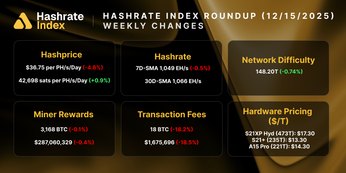
The Data Doesn’t Lie: Forward Hashprice Is 80% Better
Hashprice has become the go-to metric for gauging revenue potential. But here’s the catch: it’s a poor forecasting tool. Miners need the forward market instead.
In the world of Bitcoin mining, hashprice has become the go-to metric for gauging revenue potential. But here’s the catch: it’s a poor forecasting tool, falling short by a staggering 80% compared to the alternative. Miners looking to future-proof their strategies need to shift focus from spot hashprice to the forward market instead. Here’s why.
Spot Hashprice as a Reference
Spot hashprice, measured in dollars per petahash per second per day ($/PH/s/Day), reflects the immediate revenue miners can earn per unit of computational power. While useful for real-time operations, it falters when forecasting future profitability. The reason lies in the nature of hashrate as a commodity.
Storable vs. Non-Storable Commodities
Economists classify commodities into two types: storable and non-storable.
- Storable commodities (e.g., wheat, oil, or Bitcoin itself) can be stored indefinitely without degrading. Futures prices for these goods tend to mirror current spot prices, adjusted for storage costs.
- Non-storable commodities (e.g., electricity or hashrate) are consumed as they are produced. Their futures prices reflect anticipated shifts in supply and demand rather than spot prices, as they lack carry costs.
This distinction is critical for Bitcoin mining. While Bitcoin is a storable commodity with a predictable price relationship between spot and futures markets, hashrate is non-storable. It’s inherently tied to immediate conditions like network demand and hardware availability, making spot hashprice a weak predictor of future revenues.
Application in Bitcoin and Hashrate
Hashrate, unlike Bitcoin, can’t be saved for later. It’s a real-time resource produced and consumed simultaneously, which limits spot hashprice’s utility as a forecasting tool. Spot hashprice reflects only the current market state — network difficulty, energy costs, and block rewards at the moment — not the conditions likely to emerge tomorrow or next quarter.
For miners planning ahead, this shortsightedness can be costly. Enter the forward hashprice market.
Why the Forward Market Matters
Here’s where the forward market for hashrate adds value. Unlike spot hashprice, forward market pricing can factor in anticipated changes in:
- Network Difficulty: If the network anticipates a large influx of new miners or the shutdown of others (perhaps due to changes in regulation or mining economics), forward prices can adjust accordingly. Anticipated changes in energy markets (such as seasonal shifts or policy changes) can also be priced in. Spot hashprice wouldn’t reflect these changes directly but forward pricing will, based on industry production and distribution projections.
- Transaction Fees: fees collected by miners are uncertain and vary between blocks. If the network anticipates a change in demand for blockspace (e.g., due to increased on-chain activity from non-standard transactions), this can be reflected in forward prices.
By integrating these variables, forward market pricing becomes a robust forecasting tool, offering miners critical insights into future profitability.
Forward Hashprice is 80% Better
We put this theory to the test by analyzing forecast accuracy between December 2023 and November 2024. Using the Mean Absolute Error (MAE) — which measures how closely predictions align with actual outcomes — we compared spot hashprice with forward market predictions.
- Spot hashprice MAE: 0.00046589
- Forward hashprice MAE: 0.00009244

The results speak volumes. Forward hashprice predictions were 80% closer to actual outcomes, proving that the forward market holds significantly more information about the future than spot hashprice. While no tool offers perfect accuracy, forward pricing clearly gives miners an edge.
Why This Matters for Bitcoin Miners
The economic framework around storable vs. non-storable commodities underpins why forward hashprice outshines spot as a predictive metric. For miners, the forward market isn’t just a helpful tool — it’s a strategic necessity. By leveraging forward pricing, miners can:
- Make better long-term decisions.
- Reduce the risks of volatile, spot-reliant forecasts.
- Gain a clearer perspective on market trends and profitability shifts.
In a space as competitive and dynamic as Bitcoin mining, miners who track the forward market will outmaneuver those relying solely on spot metrics. With 80% better predictive accuracy, forward hashprice is the map miners need to navigate an ever-shifting landscape.
Conclusion
Spot hashprice may serve as a day-to-day revenue reference, but its limitations as a forecasting tool are glaring. Hashrate’s non-storable nature means the forward market captures far more nuanced data, offering a clearer lens into the future. For miners seeking to stay ahead, embracing forward hashprice isn’t just a smart move — it’s essential.
Disclaimer
This content is for informational purposes only, you should not construe any such information or other material as legal, investment, financial, or other advice. Nothing contained in our content constitutes a solicitation, recommendation, endorsement, or offer by Luxor or any of Luxor’s employees to buy or sell any derivatives or other financial instruments in this or in any other jurisdiction in which such solicitation or offer would be unlawful under the derivatives laws of such jurisdiction.
There are risks associated with trading derivatives. Trading in derivatives involves risk of loss, loss of principal is possible.
Hashrate Index Newsletter
Join the newsletter to receive the latest updates in your inbox.









